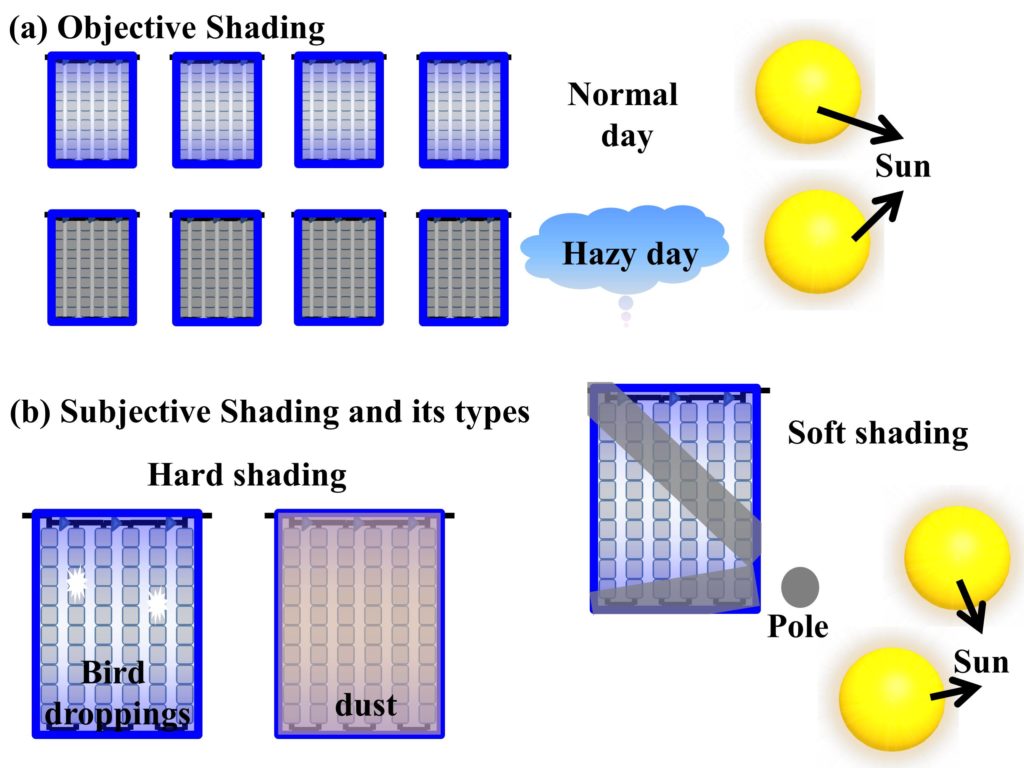Shading
The key aspect that reduces the power from a photovoltaic (PV) system is “shading”. Shading comes from shade or shadow, which is actually a dark figure of an object blocking the path of the light. In terms of PV systems, the shading is the covering of a full or a part of a solar panel. There are two major types of shading, which are mentioned below.
- Objective shading
- Subjective shading
Objective shading
Objective shading refers to shading caused by underlying weather conditions of a specific area. This can be due to a hazy day or due to excessive pollution causing a blockage in the path of light that reduces the incoming irradiance (power per meter squared). This type of shading can be either temporary (if it is dependent on weather) or it can be permanent (if it is happening due to pollution) and would require human intervention. Objective shading affects the entire PV system and it, therefore, operates with low efficiency inversely proportional to how much irradiance is blocked? This means that if more irradiance from the sun is blocked, lower will be output power from the PV system and vice versa. A visual depiction of objective shading is shown in Fig. 1(a).

Subjective shading
The subjective shading is a direct cause of an object blocking irradiance. The subjective shading is caused due to shadow from a building, dust or bird droppings, etc. Depending on vast variation in types of subjective shading, it can be further classified into two categories [also depicted in Fig. 1(b)].
- Static shading or hard shading
- Dynamic Shading or soft shading
Static shading or hard shading
Static shading or hard shading occurs when the solar panel is covered by dust particles or any other solid particles such as bird droppings which partially or completely block solar irradiance reaching the solar panel. When the solar panel is covered with dust, a fine layer of dirt is formed on top of the solar panel which drops the power output from a solar panel. If this layer gets thick enough, it will completely block the sunlight from reaching the panel. Another cause of static or hard shading is bird droppings. This factor can be avoided if a PV system is installed on roofs of building with high altitudes. However, on lower altitudes, the effect of bird droppings is much more pronounced than dust accumulation. Both of these factors of dust accumulation and bird droppings can be avoided by cleaning the panels. It is important to mention that the effect of dust accumulation is evenly distributed to the whole PV installation whereas, the effect of bird droppings is localized to a single panel.
Dynamic shading or soft shading
Dynamic or soft shading occurs when there is an object that is blocking the sunlight from reaching the solar panel. This object can be a tree, building, or any stationary object. Dynamic shading that covers a portion of the PV panel is also known as partial shading. This type of shading is known as dynamic because the shadow shifts its position dynamically all day long because of the relative position of the sun. As the earth spins around its own axis, the relative position of the sun changes, which changes the shape and size of the shade. Therefore, this type of shade is least when the sun is shining right above the PV installation around noon (in some places) and becomes greater at other ends of dawn and dusk. This type of shading cannot be avoided unless the object is removed or the panels are shifted to a position where a particular shade does not affect it for a whole day. The solar panels are equipped with bypass diodes that bypass the string cells experiencing shading, therefore reducing some output voltage but preserving high efficiency from other cells. Some other techniques involving the use of central inverters, microinverters, and string level optimization can also be helpful in reducing the effect of partial shading and dynamic shading.
